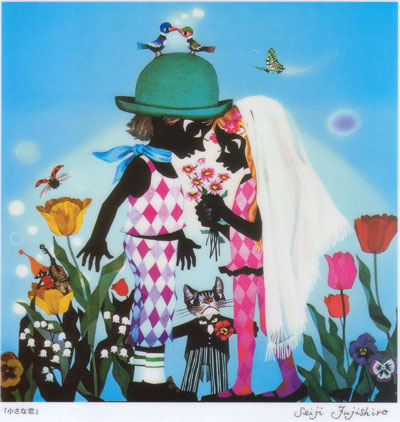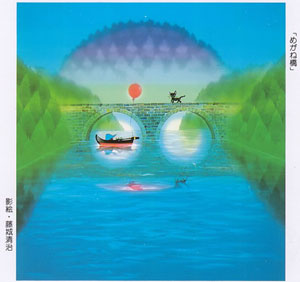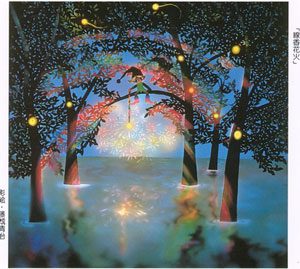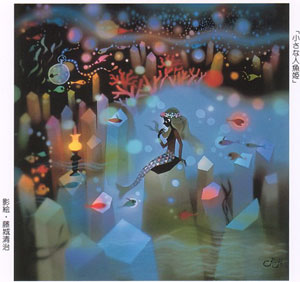
"Chisana Koi" ("Small Love") by Seiji Fujishiro

The purpose of this page is to hopefully spread the awareness of the art of Seiji Fujishiro, the favorite Japanese artist of my wife's and mine. Please click on the pictures for larger versions of the images. We have visited Seiji Fujishiro's museum in the highlands of Nagano Prefecture twice, and during our vacation during Golden Week we had the opportunity to visit his museum in Yamanashi Prefecture (home of Mt. Fuji). Mayu's mother introduced us to his works four years ago when I first visited Japan. Immediately I fell in love with his artwork. My wife and I have loved his artwork for many years, but most people have never seen his work before, even here in Japan.

Fujishiro's museums are dark, with the only light sources coming from behind his art, making colorful silhouettes. His art style is called "kiri-e". "Kiri" comes from the work "kiru" which means cut, so I guess it translates to "cut-out art." It's popular in Japan, but only a few artists are known for it. The medium is cut paper and other materials. Upon close inspection, one will find that the art is actually three dimensional; the paper is placed in three dimensions from behind the glass, giving the scenes a sense of distance that leaves some objects out of focus. The beauty of the illuminated artwork is lost somewhat on printed matter.
Color and light are what makes his works beautiful. Detail is not shown on faces or clothing or the shape of objects, for the contrast of light and dark and color are the main focus of his art. So shapes are generally basic, but the intricate detail of the cutting such as the leaves on the trees is very impressive.

I think Fujishiro's art is representative of the distinctly Japanese artistic ability to capture a perfect blend of fantasy and cuteness that I haven't seen anywhere else. Although my wife doesn't care for traditional Japanese things (which seem boring to a Japanese girl), I enjoy ukiyo-e woodblock prints, especially the ones by Hiroshige Ando. I believe that the beauty of ukiyo-e is contained in its simplicity, and that this is why Western artists such as the French Impressionists were drawn to it and attempted to emulate it in their own artwork. I think this simplicity is carried on to Japanese popular art today. For example, if you would find a greeting card in America which features a teddy bear, it would look fuzzy and usually have a silly, gooey expression on its face. However a Japanese gretting card's teddy bear would be drawn with simple shapes with little detail, thus making it cute. Hello Kitty would be another example. She is never drawn with a mouth, and her face is expressionless. Therefore no matter what mood you're in, Hello Kitty makes people feel good.
In terms of Fujishiro's characters, people and animals are usually cut from black paper. Facial expressions are carried mainly by the wide eyes and the general atmosphere of the whole picture, whether it is bright and cheerful or dark and mysterious.

Visiting Fujishiro's museums gives me such a sense of peace every time. His beautiful art radiates serenity, and tranquil ambient music always plays in the background. My body and mind are relaxed as peacefulness surrounds me. Each time we visit one of his museums, Mayu and I never leave the giftshop empty handed afterwards. Our collection of his prints is growing and we hang them on our walls. Seiji Fujishiro is by far our favorite artist.
Here are some links I've found on the Web regarding Fujishiro's works:
Imaginatorium's selection of Fujishiro's jigsaw puzzles! This site features jigsaw puzzles from Japan.
Seiji-Fujishiro.com, apparently the official homepage.
Shosenkyo Kage-e Musemum in Yamanashi Prefecture.
Ike no Taira Hotel Museum is the Fujishiro art museum I've visited the most, in the highlands of beautiful Nagano Prefecture.
 Go back to the "Greg's Life" Table of Contents
Go back to the "Greg's Life" Table of Contents